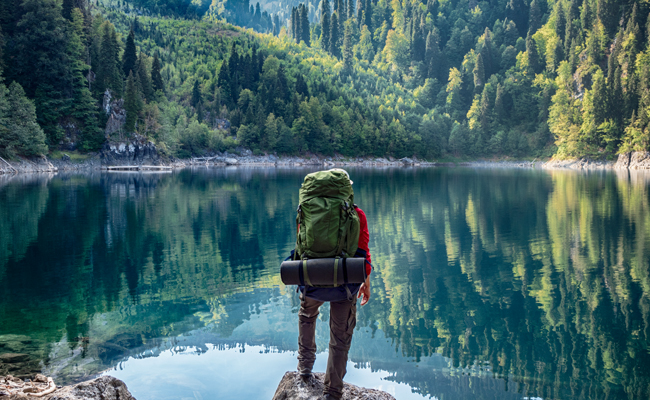Editor’s Note: This is a guest post from Tony DiLorenzo from Fit Marriage.
From the Mexican border to the vast expanse of the Sierra Nevada Mountain range to snow-capped Mt. Rainer and beyond, there is truly nothing like leaving everything behind to hike the Pacific Crest Trail (PCT). Each year, around 300 brave souls attempt to “thru hike” the entire 2,650-mile trek, experiencing six of the seven North American ecozones in the process.
As I experienced firsthand, adventure awaits along every step of the PCT, as you wake to the sun and lay your head to rest at dusk at the end of each demanding day. Over the course of 4-6 months, everyday life revolves around your forward progress along the trail. This is back-to-basics, rugged living at its finest.
There are some obvious abilities that must be mastered before setting forth on an ultra-backpacking adventure, such as carrying a heavy load on your back, way-finding, and fire starting. In fact, much of the time spent hiking can seem a bit mundane.
However, there are some much more unusual skills that will be needed to survive a trek of this nature and return a better man.
1. Hitchhiking
It is common when hiking a long trail to have to hitchhike into towns to resupply. These can be a short 5-mile hitch or as long as 30-plus miles. The simple thing to do is put your thumb up and get a ride. Unfortunately, in this day and age, it’s not usually that easy. Even though you may look like a thru-hiker, which is not an uncommon sight along major trails, there is still an unknown element about you, especially when you start to look like the Unabomber between resupply stops.
Over the course of 138 days of hiking, I learned several strategies that saved me hours of sitting by the road. It got me to my resupply towns quickly and effectively so that I could eat, shop, drink beer, and relax for a while.
- Freshen up before you step out near the road. Get out a towel and some water, and clean off your face, arms and legs. Presentation is everything in the business world, and it makes a big difference when you are seeking a ride in remote areas as well.
- Make sure you smile when you put your thumb up. You’d be surprised how many times drivers shared that they picked me up because I had a smile on my face and looked clean.
- Position yourself where a vehicle can pull over. If there is no convenient place to pick you up, most drivers will zoom by without a second thought. Would you pick up a hitchhiker if you couldn’t pull over safely? The optimal spot may not be where the trail crosses the road; it’s worth a short additional walk to find a prime pick-up location.
- Humanize yourself even more and lighten the mood by holding a candy bar or something fun. I witnessed another hiker grabbing attention by holding a blow-up pink flamingo. After sitting at one location for a bit longer than I wanted, I held up a Snickers bar and the next car that passed stopped to pick me up for a lift into town.
2. Sleeping Under the Stars
Don’t be afraid of the night. There is much to see and enjoy as the sun sets and the moon and stars shine in ways you can’t experience in suburbia. Connecting with your surroundings each evening provides a greater sense of what’s around you, and I found that sleeping without a tent as much as possible was really enjoyable. Putting up a tent requires work and a specific amount of flat area to set up, but you can sleep almost anywhere you want when you lay beneath the stars.
During the early sections of the PCT, the heat is a major factor that you must contend with each day until you arrive at the gateway to the Sierra Nevada Mountains. Until then, you must hike very early in the morning before the heat of the day pushes you to cool places for rest. Once the mid-day heat has subsided, it’s time to hike well into the evening as the temperatures begin to fall. It is during this time that sleeping under the stars is the most easy and enjoyable.
When it is dark out and you are weary from the long day, the last thing you want to do is mess with preparing a tent. Instead, I followed this simple process for setting up camp in just a few minutes.
- Put down a cut-to-size ground cloth made of Tyvek, place your sleeping pad on top of the ground cloth, and then put your sleeping bag on top of your sleeping pad.
- Grab your unused clothes, stuff them into a stuff sack, and use this as your pillow.
- Enjoy the evening air before you fade away into a restful sleep.
3. Confronting Deadly Animals
Rattlesnakes, bears, marmots, osprey and mountain goats are just a few of the wild things you are likely to encounter through the varied terrain of the PCT . However, there are two primary animals that you must concern yourself with during your hike because of their propensity to attack you when they feel threatened.
Rattlesnakes and bears are beautiful and fascinating to observe in their natural habitat. But both don’t want anything to do with humans in their territory, and they can kill you.
When it comes to rattlesnakes, you have to be highly aware of where you are walking. Looking down, striking a walking stick before entering dense brush, and listening for the distinctive rattle will keep you walking toward your destination without a dose of venom in your bloodstream.
When an encounter does occur, you’re likely to be facing a coiled rattlesnake, which will have your arm hairs standing on end. If you have room to circle around it safely, do so. Don’t lollygag here, but move quickly. If not, take off your backpack, and place it in front of your legs as close as you can to your feet. With the backpack protecting your legs, pass as far from the rattlesnake as possible, as quickly as you can.
I employed this backpack-covering technique myself and lived to tell you about it. As I moved past the rattlesnake, it struck and only hit my backpack before falling to the ground. Then it was time to run so it wouldn’t get a second chance.
Many of the bears you’ll see are as afraid of you as you are of them, provided you keep your distance. One of the best things you can carry with you is bear pepper spray while in their territory. Make sure you have it handy. It will not do you any good if a bear comes charging, and it’s buried in your backpack.
The encounters with wildlife are incredible when you hike a long trail. Be sure to bring along a small and compact monocular to get a glimpse of the wonderful creation that is living and thriving around you during your adventure.
4. Crossing Raging Rivers
As you hike your way through mountainous regions, you’ll eventually hit the high country where you’ll be required to cross raging, early-summer runoff rivers. Depending on the snow fall from the winter before, these rivers can be swollen to great and unexpected depths. If not approached properly, these rivers will take you for an unwelcome ride that you weren’t expecting.
During your trip preparations, be sure to include a high-quality trail guide, which will inform you of the raging rivers you’re most likely to encounter. Plan your crossing of these rivers early in the morning when the evening cold has slowed the melt-off.
Many times, the trail crossing is within an area where the river is raging. Clearly, this is not the place you want to traverse. Instead, you need to patiently follow a plan to get you to the other side safely.
- Walk upstream as you follow the river to a spot where the water is calm.
- Once you find your spot, locate a large tree branch that can be used while crossing.
- Take off your backpack and hold it over your head or place all of your contents in a garbage bag so that you can wear your pack high on your back.
- Enter the river with shoes and move with slow and steady confidence using a walking stick to probe and for balance as you make your way to the opposite bank.
5. Resupplying
Hiking 8-12 hours to cover anywhere from 15-30 miles each day will require fueling your body as often as possible. Each town you come across is an opportunity to take in as many calories as you can before hitting the trail again.
While in town, consume large quantities of burritos, omelets, hamburgers, or fries. Drink beer, sport drinks, or iced tea. Hit the local buffet and graze for several hours or sit in a local cafe to sip coffee and eat desserts. You won’t have to concern yourself with gaining weight, as you’ll be burning 5,000-8,000 calories a day.
One trick when it comes to resupplying is to get to town as soon and as early as you can in the morning. This way, you’ll be able to eat breakfast, resupply your provisions, grab lunch and then hitchhike back to the trail. You get the bonus of enjoying two big meals and, if at all possible, you should grab something that will pack well for dinner. It could be days before your next opportunity to interact with civilization.
In most trail towns, you will be shopping at a small grocery store and sometimes at the local gas station. Your options will be limited, so you’ll need to be creative as you purchase what you will be eating for the next leg of your trip. Here are some suggested provisions for the trail:
- Breakfast – Brownies, protein bars, oatmeal
- Snacks – Nuts, cheese, candy bars, seeds
- Lunch – Chips in a can, cheese, crackers, PB&J, jerky, fruit
- Dinner – Mashed potatoes, rice, pasta, dehydrated mushrooms, carrots, peas, cheese, canned mussels
If you think you’ve got what it takes to leave modern conveniences behind and go explore the wilderness on an ultra-backpacking adventure, I encourage you to check out one of the three National Scenic Trails in North America:
Get your hitchhiking thumb ready, grab some trail mix in bulk, and Man Up as you prepare for the adventure of a lifetime!
__________________________________________________
Tony DiLorenzo is the co-founder of Fit Marriage where he helps busy guys get fit so they can enjoy the everyday adventures of being a strong husband and an awesome dad. If you’re ready to Man Up, get started today by picking up a free fitness plan.








